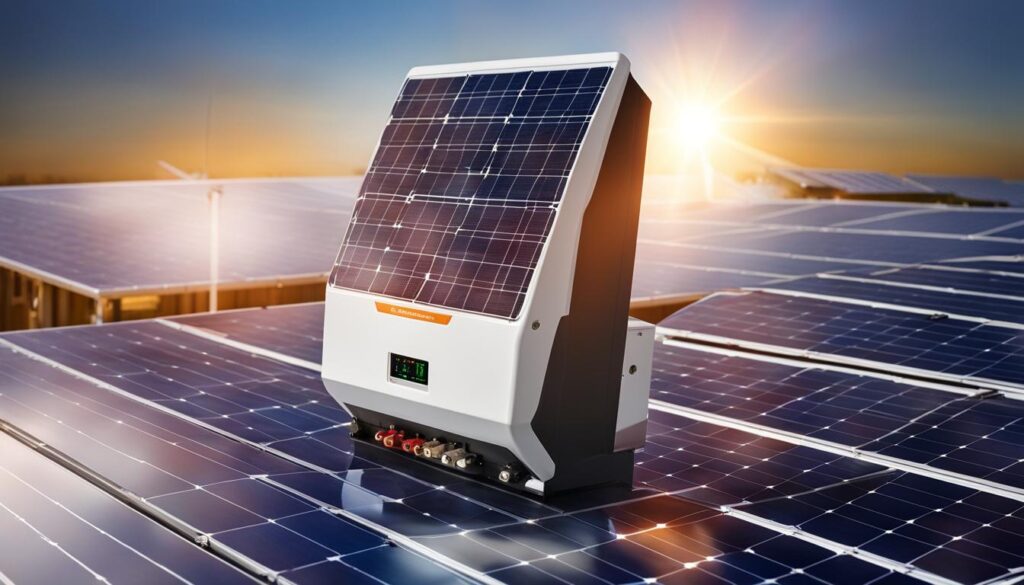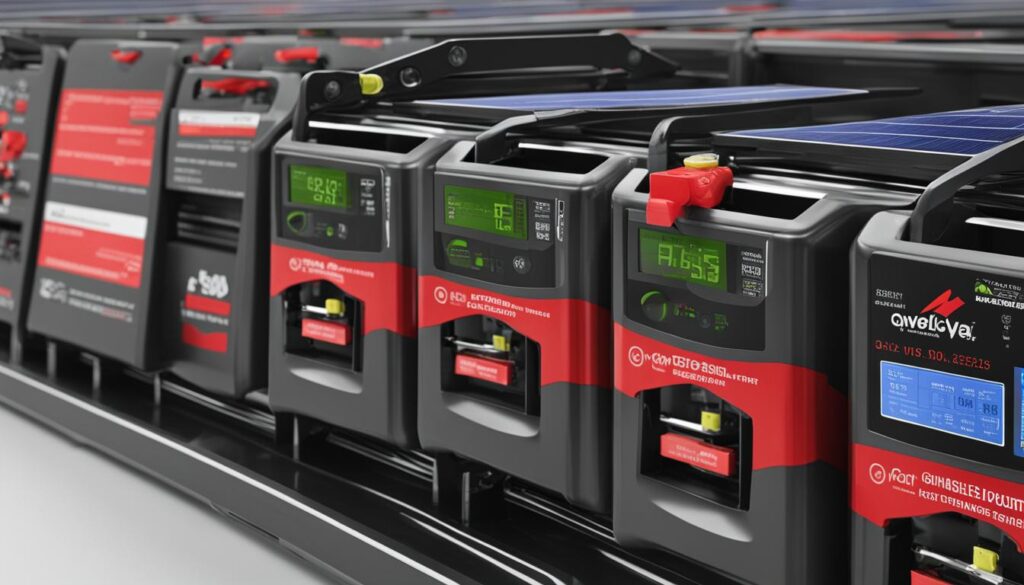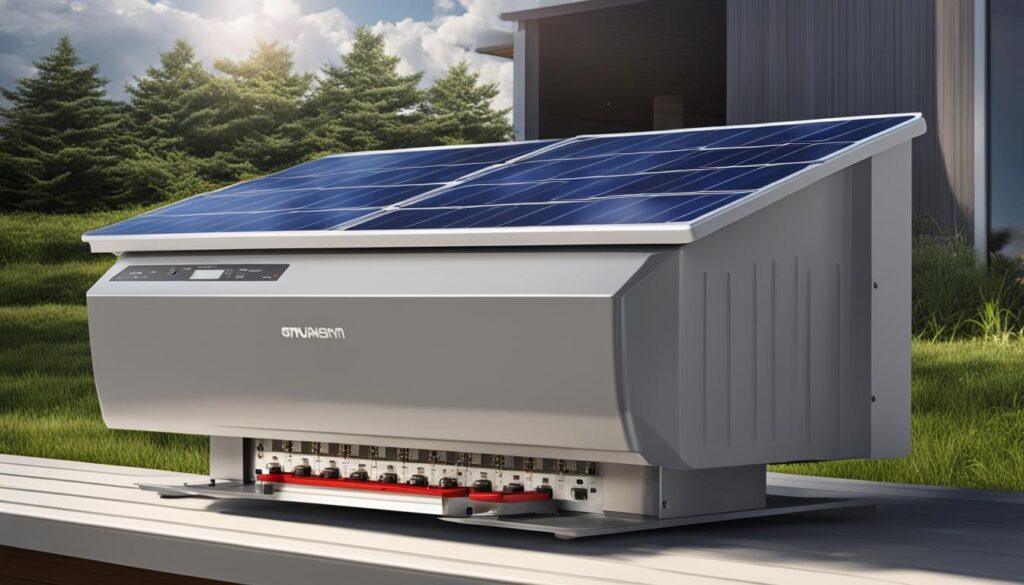An on grid solar inverter is a crucial component of the on-grid solar system. It converts the DC electricity generated by the solar panels into usable AC electricity. The on–grid inverter also regulates the current flow and ensures system safety. It allows two-way communication with the power grid, feeding excess energy back into the grid and drawing energy when needed. There are two main types of on-grid solar inverters: string inverters, which are directly connected to the grid, and micro-inverters, which are installed individually on each solar panel. On grid solar inverters are suitable for both domestic and commercial applications and offer benefits such as easy maintenance, optimized energy production, and anti-islanding protection.
Key Takeaways
- On-grid solar inverters convert DC electricity into usable AC electricity.
- They allow two-way communication with the power grid.
- There are two main types of on-grid solar inverters: string inverters and micro-inverters.
- On-grid solar inverters are suitable for both domestic and commercial applications.
- They offer benefits such as easy maintenance, optimized energy production, and anti-islanding protection.
Functions of an On Grid Solar Inverter
An on-grid solar inverter serves several important functions in a solar power system. Its primary role is to convert the direct current (DC) electricity generated by the solar panels into alternating current (AC) electricity that can be used to power household appliances. This conversion is crucial because most appliances and electronics operate on AC power, and the on-grid inverter ensures compatibility.
In addition to the conversion function, an on-grid solar inverter also plays a vital role in system safety. It is equipped with features that can detect and shut down the system in the event of an electrical arc, protecting both the system and the household from potential hazards. This safety mechanism ensures the smooth operation of the solar power system and minimizes the risk of electrical accidents.
Another important function of an on-grid solar inverter is to optimize and regulate the power output. It monitors the solar energy production and adjusts the power output to deal with fluctuations in sunlight intensity. This optimization ensures that the system operates at its maximum efficiency and maximizes the energy production from the solar panels. The grid-tied solar inverter also allows for two-way communication with the power grid, enabling the feeding of excess energy back into the grid and drawing energy from the grid when needed.

Table: Comparison of String Inverters and Micro-Inverters
| String Inverters | Micro-Inverters | |
|---|---|---|
| Installation | Connected to the grid | Installed individually on each solar panel |
| Efficiency | Slightly lower due to voltage drop | Higher due to panel-level optimization |
| Shading | Performance reduced if one panel is shaded | Not affected by shading on individual panels |
| Scalability | Can handle large systems with multiple panels | Each panel operates independently, allowing for flexibility in system size |
Overall, an on grid inverter is a crucial component of a solar power system. It not only converts DC electricity into usable AC electricity but also ensures system safety and optimizes power output. Whether using a string inverter or micro-inverters, the choice depends on factors such as installation requirements, shading conditions, and system scalability. By understanding the functions and differences between these inverters, individuals can make informed decisions when choosing the right on-grid solar inverter for their specific needs.
Types of On-Grid Solar Inverter
An on-grid solar inverter is a crucial component of the on-grid solar system, responsible for converting the DC electricity generated by the solar panels into usable AC electricity. There are two main types of on-grid solar inverters: string inverters and micro-inverters.
String Inverters
- String inverters are the most commonly used type of on-grid power inverter.
- They are directly connected to the grid and do not come with a battery backup.
- String inverters are installed in a centralized location, typically near the main electrical panel of the building.
- They are suitable for situations where all the solar panels receive similar amounts of sunlight.
- String inverters are relatively cost-effective and have a long lifespan.
Micro-Inverters
- Micro-inverters are smaller in size and are installed individually on each solar panel. It’s also called as solar grid inverter
- They are ideal for situations where there is a disparity in the amount of sunlight received by different panels.
- Micro-inverters allow each panel to operate independently, optimizing power output and reducing the impact of shading or panel malfunctions.
- They offer increased system efficiency and flexibility.
- However, micro-inverters are typically more expensive than string inverters.
When choosing between string inverters and micro-inverters, it is essential to consider factors such as the specific installation requirements, budget, and energy generation goals. Consulting with a solar professional can help determine the most suitable type of on-grid solar inverter for your needs.
Applications of On-Grid Solar Inverter
On-grid solar inverters find wide application in both domestic and commercial settings, offering efficient and reliable power conversion for grid-tied systems. There are different types of on-grid solar inverters available, each suited for specific applications.
Domestic Applications
String inverters are commonly used in residential buildings for their ease of installation and cost-effectiveness. These inverters are directly connected to the power grid, allowing excess energy to be fed back to the grid and reducing electricity bills. They are suitable for small to medium-scale residential solar installations.
Micro-inverters, on the other hand, are ideal for situations where panels receive different amounts of sunlight due to shading or orientation. By installing micro-inverters on each panel, the system’s overall efficiency is maximized, ensuring optimal energy production. These inverters are commonly used in residential rooftops where shading may be an issue.
Commercial and Industrial Applications
For larger-scale applications such as commercial buildings and industries, high-capacity central inverters are used. These inverters are designed to handle the higher power demands of such establishments and can be tailored to suit specific requirements. They are typically used in grid-tie solar installations on commercial rooftops, warehouses, and factories.
| Type of On-Grid Solar Inverter | Application |
|---|---|
| String Inverter | Residential buildings |
| Micro-Inverter | Residential buildings with shading issues |
| High-Capacity Central Inverter | Commercial and industrial buildings |
Hybrid solar inverters are another option for those who require a battery backup system. These inverters allow energy to be stored in a battery bank, providing power during grid outages or during peak demand periods. They are versatile and can be used for both domestic and commercial applications, offering the benefits of grid-tied systems with the added advantage of backup power.

on grid inverter price varies depending on various factors such as capacity, manufacturer, and technology used. It is important to consider both the upfront cost and the long-term cost-efficiency when choosing an on-grid inverter. While some inverters may have a higher initial price, they may offer better performance, longer warranties, and require less maintenance, making them a more cost-effective choice in the long run.
Benefits of an On-Grid Solar Inverter
On-grid solar inverters offer several benefits that make them a popular choice for grid-tie solar systems. These inverters are designed to convert the DC electricity generated by solar panels into AC electricity that can be used in households. One of the key advantages of on-grid solar inverters is their easy maintenance and installation. Unlike off-grid systems that require additional equipment like a battery bank, on-grid systems can be set up without the need for extra components, making them more convenient and cost-effective.
Another major benefit of on-grid solar inverters is their ability to optimize energy production. These inverters are designed to produce the maximum amount of energy possible, ensuring that households can make the most of their solar power generation. Additionally, on-grid inverters come with anti-islanding protection, which shuts off the power supply to the house when the grid fails. This feature not only ensures the safety of electrical workers during maintenance but also prevents damage to appliances by adjusting the input voltage, minimizing the risk of power surges and fluctuations.
Furthermore, on-grid solar inverters provide financial benefits to homeowners. By feeding excess energy back into the grid, households can earn credits on their electricity bills through net metering programs. This means that when the solar panels produce more energy than the household consumes, the excess energy is sent back to the grid, offsetting the cost of electricity drawn from the grid during periods of low solar generation. This results in reduced electricity bills and increased savings over time.
Benefits of On-Grid Solar Inverters:
- Easy maintenance and installation
- Optimized energy production
- Anti-islanding protection for safety
- Financial benefits through net metering
Overall, on-grid solar inverters offer numerous benefits that make them an attractive choice for homeowners and businesses alike. From easy installation and maintenance to optimized energy production and financial savings, these inverters provide a reliable and efficient solution for harnessing solar power.
| Benefits | Explanation |
|---|---|
| Easy maintenance and installation | On grid solar inverters are easier to set up and require less maintenance compared to off-grid systems. |
| Optimized energy production | On grid solar inverter maximize the energy production of solar panels, ensuring higher efficiency and output. |
| Anti-islanding protection for safety | In the event of a grid failure, on-grid inverters automatically disconnect to ensure the safety of electrical workers and protect appliances from power fluctuations. |
| Financial benefits through net metering | On-grid solar systems can earn credits on electricity bills through net metering, resulting in reduced costs and increased savings. |
Price of On-Grid Solar Inverter in India
When considering the purchase of an on grid solar inverter in India, the price is an important factor to consider. The cost of an on-grid inverter can vary depending on various factors such as the capacity, manufacturer, and technology used. It is crucial to strike a balance between affordability and quality to ensure long-term cost-efficiency.
While it may be tempting to opt for a lower-priced on-grid inverter, it is essential to consider the warranty and overall quality offered by the manufacturer. Choosing a low-quality product solely based on price can result in inefficiencies and frequent servicing requirements in the long run. It is advisable to consult with installation companies and experts to make an informed decision based on individual needs and requirements.
Investing in a high-quality on-grid solar inverter may initially involve a higher upfront cost but can prove to be more economical in the long term. A reliable and efficient on-grid inverter is likely to have a longer lifespan, require minimal maintenance, and result in optimized energy production. Additionally, reputable manufacturers often offer warranties that provide added peace of mind and protection against potential malfunctions.
| Capacity | Manufacturer | Technology | Price Range (INR) |
|---|---|---|---|
| 1 kW | Luminous | String Inverter | 18,000 – 25,000 |
| 3 kW | Growatt | String Inverter | 30,000 – 40,000 |
| 5 kW | Fronius | String Inverter | 60,000 – 70,000 |
| 400W | Enphase | Micro Inverter | 15,000 – 20,000 |
Please note that the above price ranges are approximate and may vary based on market conditions and other factors. It is advisable to consult with authorized distributors or installation companies for the most accurate and up-to-date pricing information.
Considering the long-term benefits of an on-grid solar inverter, it is crucial to prioritize quality and reliability over the initial cost. By investing in a high-quality on-grid inverter that meets individual requirements, homeowners and businesses can experience optimized energy production, reduced electricity bills, and contribute to a greener and more sustainable future.
Conclusion
Purchasing an on-grid solar inverter is a smart decision for anyone looking to harness the power of solar energy. With their easy maintenance and optimized energy production, on- grid solar inverters are a reliable choice for both domestic and commercial applications in India.
One of the key advantages of on grid solar inverter is their anti-islanding protection, which ensures the safety of electrical workers and prevents damage to appliances during grid failures. This feature sets them apart from other types of inverters and makes them a dependable solution for uninterrupted power supply.
For those considering an on-grid solar inverter, it is important to evaluate the specific needs and requirements of their application. Additionally, on-grid hybrid solar inverters offer the added benefit of battery backup, providing peace of mind during power outages.
While the price of on-grid solar inverters in India can vary, it is important to prioritize quality and warranty over low cost. Consulting with an experienced installation company can help determine the best on-grid inverter for individual needs, ensuring a long-lasting and efficient solar power system.
FAQ
What is the function of an on-grid solar inverter?
An on-grid solar inverter converts the DC electricity generated by the solar panels into AC electricity that can be used in households. It also regulates power output and ensures system safety.
What are the types of on-grid solar inverters?
There are two main types of on-grid solar inverters: string inverters, which are directly connected to the grid, and micro-inverters, which are installed individually on each solar panel.
Where can on-grid solar inverters be used?
On-grid solar inverters/ grid-connected inverter are suitable for both domestic and commercial applications.
What are the benefits of using an on-grid solar inverter?
On-grid solar inverters/ grid-tie inverter offer benefits such as easy maintenance, optimized energy production, and anti-islanding protection.
How much does an on-grid solar inverter cost in India?
The price of an on-grid solar inverter in India varies depending on factors such as capacity, manufacturer, and technology used.

